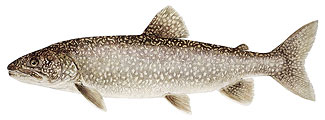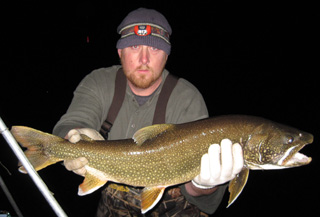Lake Trout
Salvelinus namaycush
 NH Conservation Status: Special Concern
NH Conservation Status: Special Concern
State Rank: Secure
Distribution: Lake trout are widely distributed throughout northern North America including much of Canada (with the exception of some Hudson Bay Drainages), Alaska, the Great Lakes Region, the northwestern states, and northern New England. Populations are found in several oligotrophic water bodies in New Hampshire. Native populations exist in both central and northern New Hampshire (Squam Lake, Winnipesaukee Lake, Newfound Lake, First Connecticut Lake and Second Connecticut Lake). Stocking programs have introduced self-sustaining populations of lake trout in 17 additional water bodies, increasing their distribution to include more water bodies in the central, southwestern, and northern parts of the state. The species has been introduced in other parts of the world. In parts of the western United States, their introduction has resulted in the displacement of sensitive native trout species.
Description: The species can be quite variable in coloration but still maintains a typical trout like body shape. Typical of all fish in the salmonidae family, lake trout have an adipose fin. Lake trout are noted for abundant white or pale yellow spots which are present on the head, fins, and body of the species. The main background color can range from almost black to light green, gray, or light brown. The coloration of the underbelly can vary between yellow, white, or light brown. As with brook trout, some lake trout fins can have distinct white boarders on the outer edges. The white coloration is often not as brilliant or contrasting as with the fins of a brook trout. The lake trout has a deeply forked tail.
Species commonly confused with: Brook trout, brown trout. Young-of-the-year lake trout can resemble other salmonids in the same age class. They have similar coloration, parr marks, and body shape. That being said, young-of-the-year lake trout are rarely observed because of the habitat they occupy.
Habitat: Although lake trout can exist in rivers and shallow ponds in parts of their range, lake trout occupy only deep-water lakes in New Hampshire. When warm summer air temperatures cause lakes to stratify, lake trout reside below the thermocline in the hypolimnion layer. The species can make excursions above the thermocline into warmer water temperatures but these trips are quick foraging excursions and usually short lived. Lake trout generally prefer water temperatures around 50°F but are able to survive in waters that reach as high as 60°F. During cooler periods without lake stratification, lake trout have the ability to move freely into the shallows. Dissolved oxygen levels required are typically in excess of 5 or 6 parts per million. Lakes and ponds with suitable dissolved oxygen levels are a reflection of water quality. Lakes and ponds with excessive nutrient inputs (fertilizers, sewage) can create an oxygen deficiency in the hypolimnion layer as the nutrients lead to increases in algae and phytoplankton. When algae and phytoplankton die it sinks to the bottom where it is consumed by bacteria, using up oxygen in the process.
Life History: Lake trout are a relatively slow growing, long-lived fish by New Hampshire standards. It can take as long as 7 years for the species to reach maturation. They can live well in excess of 25 years and up to 60 years. The species spawns in late October/early November in New Hampshire when water temperatures drop to around 48-52°F. Spawning occurs in shallow rocky reefs that are clear of sand and silt due to strong currents or wave action. Males typically far outnumber ripe females on the spawning reef. Often, males can be observed scouting out the spawning location during the day but mass congregations of lake trout typically begin around dusk. Female lake trout deposit eggs in a broadcast fashion. The eggs are fertilized and then fall in spaces between rocks. Areas where rocks are covered in silt or embedded in sand are avoided because the deposited eggs are susceptible to predation by several different species (fallfish, rainbow trout, salmon, crayfish, white sucker, etc.). The eggs will incubate and develop over the winter and hatch in late winter/early spring. Once hatched, the juveniles make their way from the shallows to deeper water.
Lake trout have the ability to feed on a wide variety of different prey items. They can even rely on plankton if traditional food sources are out of reach during the times when they are restricted to depths below the thermocline. In New Hampshire, rainbow smelt are the preferred food source for lake trout in most of the lakes and ponds they are found in. They will also utilize essentially any other healthy populations of fish species, crustaceans, and aquatic macroinvertebrates when accessible.
Lake trout lack natural predators during most of their lives with the exception of a chance encounter with a mink, otter, or piscivorous bird during the time that they are vulnerable in the shallows during spawning. They are a popular sport fish in New Hampshire, being pursued during the open water and icefishing season. NH Fish and Game biologists monitor lake trout populations to ensure harvest rates are kept at suitable levels.
Origin: Native

Conservation/Management: Lake Trout are identified as a species of concern in the New Hampshire Wildlife Action Plan due to its limited range in the state and its dependence on a very specific cold-water habitat. Management decisions are guided by a Lake Trout Management Plan, drafted by the Inland Fisheries Division of the New Hampshire Fish and Game Department.
The susceptibility of lake trout egg survival is of concern in locations where fall lake level drawdowns occur. Eggs deposited between rocks as shallow as 1 to 3 feet can be exposed to the open atmosphere or frozen within the ice as lakes freeze. If a fall drawdown is deemed necessary for flood storage, water level adjustments should be made before the lake trout spawn begins.



